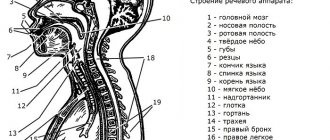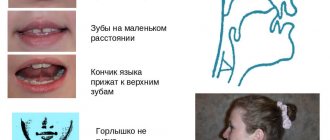The emergence of speech in humans and the formation of sounds is possible thanks to the speech apparatus. The speech apparatus is a set of coordinated organs that help form the voice, regulate it and form it into meaningful expressions. Thus, the human speech apparatus includes all elements directly involved in the creation of sounds - the articulatory apparatus, including the central nervous system, respiratory organs - lungs and bronchi, throat and larynx, oral and nasal cavities.
The structure of the speech apparatus
The structure of the human speech apparatus, that is, its structure, is divided into two sections - the central and peripheral sections. The central link is the human brain with its synapses and nerves. The central speech apparatus also includes the higher parts of the central nervous system. The peripheral department, also known as the executive department, is a whole community of elements of the body that ensure the formation of voice and speech. Further, according to the structure, the peripheral part of the speech apparatus is divided into three subsections:
- The department that regulates respiratory processes. Breathing is an important function of the body. It is implemented by special nerve centers and occurs automatically. Sounds from the body always come out during exhalation, and the air wave formed at this moment helps to perform two tasks at once - articulatory function and voice formation. This section includes the lungs and bronchi, the muscles located between the ribs, and the diaphragm.
- Voice department. The voice has three characteristics. This is its power, timbre and height. The work of the vocal cords causes vibrations in the air, transmitted to the outside world, perceived as voice.
- The articulatory apparatus is the department that directly forms sounds into speech. Consists of active and passive organs. Active organs of articulation are movable, helping to form sounds. The main organs of articulation are the lips and tongue, palate and jaw. Their changes in position lead to the creation of narrowings in different places of the articulation department. The character of the sound produced depends on this position. The mandible helps create stressed vowels. The tongue is the main muscle of the articulatory apparatus. The clarity of pronounced sounds depends on its ability to be flexible and transformative. The lips are also a moving part and contribute to the formation of vowel sounds and speech, they are an important organ in the articulation of words, which is helped by the specific placement of the tongue.
Passive organs included in the articulatory apparatus are immobile organs. Their main task is to be the foundation, the basis for active organs. Passive organs include teeth and the entire oral cavity, and the hard palate. As well as the pharynx and larynx. Although they are motionless, they still influence, albeit slightly, the speech potential and character of a person’s speech.
Anatomical and physiological mechanisms of speech
Knowledge of the anatomical and physiological mechanisms of speech, i.e. structure and functional organization of speech activity, allows us to imagine the complex mechanism of speech. The speech act is carried out by a complex system of organs, in which the main, leading role belongs to the activity of the brain.
The structure of the speech apparatus.
The speech apparatus consists of two closely interconnected parts: the central (regulating) speech apparatus and the peripheral (performing) speech apparatus.
1. The central speech apparatus is located in the brain. It consists of: - cerebral cortex (mainly the left hemisphere) - subcortical nodes - pathways - nuclei of the brainstem (primarily the medulla oblongata) - nerves going to the respiratory, vocal and articulatory muscles.
What is the function of the central speech apparatus and its departments??
Speech, like other manifestations of higher nervous activity, develops at the basis of reflexes. Speech reflexes are associated with the activity of various parts of the brain. However, some parts of the cerebral cortex are of primary importance in the formation of speech. These are the frontal, temporal, parietal and occipital lobes, predominantly of the left hemisphere of the brain (in left-handers, the right).
— The frontal gyri (inferior) are the motor area and are involved in the formation of one’s own oral speech (Broca’s area).
— The temporal gyri (superior) are the speech-auditory area where sound stimuli arrive (Wernicke's center). Thanks to this, the process of perceiving someone else’s speech is carried out.
The parietal lobe of the cerebral cortex is important for understanding speech .
— The occipital lobe is a visual area and ensures the assimilation of written speech (the perception of letter images when reading and writing).
— The subcortical nuclei control the rhythm, tempo and expressiveness of speech.
— The pathways connect the cerebral cortex with the muscles that regulate the activity of the speech apparatus - centrifugal (motor) nerve pathways . The centrifugal pathway begins in the cerebral cortex in Broca's center.
From the periphery to the center, i.e. from the area of the speech organs to the cerebral cortex, there are centripetal pathways . The centripetal pathway begins in the proprioceptors and baroreceptors.
Proprioceptors are found inside muscles, tendons and on the articular surfaces of moving organs. Proprioceptors are excited by muscle contractions. Thanks to proprioceptors, all our muscle activity is controlled.
Baroreceptors are excited by changes in pressure on them and are located in the pharynx. When we speak, proprio- and baroreceptors are irritated, which follows a centripetal path to the cerebral cortex.
The centripetal path plays the role of a general regulator of all activities of the speech organs.
The cranial nerves originate in the nuclei of the brainstem All organs of the peripheral speech apparatus are innervated (innervation is the provision of any organ or tissue with nerve fibers, cells) by cranial nerves . The main ones are: trigeminal, facial, glossopharyngeal, vagus, accessory and sublingual.
— The trigeminal nerve innervates the muscles that move the lower jaw;
- Facial nerve - facial muscles, including muscles that move the lips, puff out and retract the cheeks;
- Glossopharyngeal and vagus nerves - muscles of the larynx and vocal folds, pharynx and soft palate. In addition, the glossopharyngeal nerve is the sensory nerve of the tongue, and the vagus nerve innervates the muscles of the respiratory and cardiac organs.
— The accessory nerve innervates the muscles of the neck, and the hypoglossal nerve supplies the muscles of the tongue with motor nerves and gives it the possibility of a variety of movements.
Through this system of cranial nerves, nerve impulses are transmitted from the central speech apparatus to the peripheral one. Nerve impulses move the speech organs.
But this path from the central speech apparatus to the peripheral one constitutes only one part of the speech mechanism. Another part of it is feedback - from the periphery to the center.
2. The peripheral speech apparatus consists of three sections: 1. Respiratory 2. Vocal 3. Articulatory (sound-producing)
The respiratory section includes the chest with lungs, bronchi and trachea .
Producing speech is closely related to breathing. Speech is formed during the exhalation phase. During the process of exhalation, the air stream simultaneously performs voice-forming and articulatory functions (in addition to another, main one - gas exchange). Breathing during speech is significantly different from usual when a person is silent. Exhalation is much longer than inhalation (while outside of speech, the duration of inhalation is approximately the same). In addition, at the time of speech, the number of respiratory movements is half as much as during normal (without speech) breathing.
It is clear that for a longer exhalation a larger supply of air is needed. Therefore, at the moment of speaking, the volume of inhaled and exhaled air increases significantly (about 3 times). The inhalation during speech becomes shorter and deeper. Another feature of speech breathing is that exhalation at the moment of speech is carried out with the active participation of the exhaled muscles (the abdominal wall and internal intercostal muscles). This ensures its greatest duration and depth, and in addition, increases the pressure of the air stream, without which sonorous speech is impossible.
The vocal section consists of the larynx with the vocal folds located in it. The larynx is a wide, short tube consisting of cartilage and soft tissue. It is located in the front of the neck and can be felt through the skin from the front and sides, especially in thin people.
From above the larynx passes into the pharynx . From below it passes into the trachea . At the border of the larynx and pharynx is the epiglottis . It consists of cartilage tissue shaped like a tongue or petal. Its front surface faces the tongue, and its back surface faces the larynx. The epiglottis serves as a valve: descending during the swallowing movement, it closes the entrance to the larynx and protects its cavity from food and saliva.
In men, the larynx is larger, and the vocal folds are longer and thicker than in women. The length of the vocal folds in women is on average 18-20 mm, in men it ranges from 20 to 24 mm.
How is voice formation or phonation accomplished?
The mechanism of voice formation is as follows. During phonation, the vocal folds are in a closed state (Figure 2). A stream of exhaled air, breaking through the closed vocal folds, somewhat pushes them apart. Due to their elasticity, as well as under the action of the laryngeal muscles, which narrow the glottis, the vocal folds return to their original state, i.e. middle position, so that as a result of the continued pressure of the exhaled air stream, it moves apart again, etc. Closing and opening continues until the pressure of the voice-forming exhalatory stream stops. Thus, during phonation, vibrations of the vocal folds occur. These vibrations occur in the transverse and not the longitudinal direction, i.e. the vocal folds move inward and outward, rather than upward and downward. As a result of vibrations of the vocal folds, the movement of the stream of exhaled air turns over the vocal folds into vibrations of air particles. These vibrations are transmitted to the environment and are perceived by us as vocal sounds. When whispering, the vocal folds do not close along their entire length: in the back part between them there remains a gap in the shape of a small equilateral triangle, through which the exhaled stream of air passes. The vocal folds do not vibrate, but the friction of the air stream against the edges of the small triangular slit causes noise, which we perceive as a whisper. The voice has strength, height, timbre. The strength of the voice depends mainly on the amplitude (span) of vibrations of the vocal folds, which is determined by the amount of air pressure, i.e. exhalation force. The resonator cavities of the extension pipe (pharynx, oral cavity, nasal cavity), which are sound amplifiers, have a significant influence on the strength of the voice. The size and shape of the resonator cavities, as well as the structural features of the larynx, affect the individual “color” of the voice, or timbre . It is thanks to timbre that we distinguish people by their voices. The pitch of the voice depends on the frequency of vibration of the vocal folds, and this in turn depends on the length, thickness and degree of tension. The longer the vocal folds, the thicker they are and the less tense they are, the lower the sound of the voice. In addition, the pitch of the voice depends on the pressure of the air stream on the vocal folds and the degree of their tension.
Articulation department . The main organs of articulation are: - tongue - lips - jaws (upper and lower) - hard palate - soft palate - alveoli Of these, the tongue, lips, soft palate and lower jaw are movable, the rest are fixed (Fig. 3).
The main organ of articulation is the tongue.
The tongue is a massive muscular organ. When the jaws are closed, it fills almost the entire oral cavity. The front part of the tongue is mobile, the back part is fixed and is called the root of the tongue. The movable part of the tongue is divided into: tip, anterior edge (blade), lateral edges and back. The complex plexus of the muscles of the tongue and the variety of their attachment points provide the ability to change the shape, position and degree of position of the tongue within a wide range. This is very important because... the tongue is involved in the formation of vowels and almost all consonant sounds (except labials).
An important role in the formation of speech sounds also belongs to the lower jaw, lips, teeth, hard and soft palates, and alveoli. Articulation consists in the fact that the listed organs form slits, or closures, that occur when the tongue approaches or touches the palate, alveoli, teeth, as well as when the lips are compressed or pressed against the teeth. The volume and clarity of speech sounds are created thanks to resonators. Resonators are located throughout the extension pipe.
The extension tube is everything that is located above the larynx: the pharynx, oral cavity and nasal cavity.
In humans, the mouth and pharynx have one cavity. This creates the possibility of pronouncing a variety of sounds. In animals (for example, a monkey), the cavities of the pharynx and mouth are connected by a very narrow gap. In humans, the pharynx and mouth form a common tube - the extension tube. It performs the important function of a speech resonator. The extension pipe in humans was formed as a result of evolution.
Due to its structure, the extension pipe can change in shape and volume. For example, the pharynx can be elongated and compressed and, conversely, very stretched. Changes in the shape and volume of the extension pipe are of great importance for the formation of speech sounds. These changes in the shape and volume of the extension pipe create the phenomenon of resonance. As a result of resonance, some overtones of speech sounds are enhanced, while others are muffled. Thus, a specific speech timbre of sounds arises. For example, when the sound a occurs, the oral cavity expands, and the pharynx narrows and stretches. And when pronouncing a sound and vice versa, the oral cavity contracts and the pharynx expands.
The larynx alone does not create a specific speech sound; it is formed not only in the larynx, but also in resonators (pharyngeal, oral and nasal). When producing speech sounds, the extension pipe performs a dual function: a resonator and a noise vibrator (the function of a sound vibrator is performed by the vocal folds, which are located in the larynx). The noise vibrator is the gaps between the lips, between the tongue and teeth, between the tongue and the hard palate, between the tongue and the alveoli, between the lips and teeth, as well as the closures between these organs broken by a stream of air.
Using a noise vibrator, voiceless consonants are formed. When the tone vibrator is turned on simultaneously (vibration of the vocal folds), voiced and sonorant consonants are formed.
The oral cavity and pharynx take part in the pronunciation of all sounds of the Russian language. If a person has correct pronunciation, then the nasal resonator is involved only in pronouncing the sounds m and n and soft variants. When pronouncing other sounds, the velum palatine, formed by the soft palate and a small uvula, closes the entrance to the nasal cavity.
So, the first section of the peripheral speech apparatus serves to supply air, the second - to form the voice, the third is a resonator that gives the sound strength and color and, thus, the characteristic sounds of our speech, arising as a result of the activity of individual active organs of the articulatory apparatus.
In order for words to be pronounced in accordance with the intended information, commands are selected in the cerebral cortex to organize speech movements. These commands are called articulation programs . The articulatory program is implemented in the executive part of the speech motor analyzer - in the respiratory, phonation and resonator systems.
Speech movements are carried out so precisely that as a result, certain speech sounds arise and oral (or expressive) speech is formed.
UNDERSTANDING ABOUT FEEDBACK COMMUNICATION . We said above that nerve impulses coming from the central speech apparatus set the organs of the peripheral speech apparatus in motion. But there is also feedback.
How is it carried out?
This connection functions in two directions: the kinesthetic pathway and the auditory pathway.
For the correct implementation of a speech act, control is necessary: 1. with the help of hearing; 2. through kinesthetic sensations.
In this case, a particularly important role belongs to kinesthetic sensations going to the cerebral cortex from the speech organs. It is kinesthetic control that allows you to prevent an error and make a correction before the sound is pronounced.
Auditory control operates only at the moment of pronouncing a sound. Thanks to sound monitoring, a person notices an error. To eliminate the error, you need to correct the articulation and control it.
Return impulses go from the speech organs to the center, where they control the position of the speech organs at which the error occurred. An impulse is then sent from the center, which causes precise articulation. And again the opposite impulse arises - about the achieved result. This continues until articulation and auditory control are matched. We can say that feedback functions as if in a ring - impulses go from the center to the periphery and then from the periphery to the center.
This is how feedback is provided and a second signaling system . An important role here belongs to systems of temporary neural connections - dynamic stereotypes that arise due to repeated perception of language elements (phonetic, lexical and grammatical) and pronunciation. The feedback system ensures automatic regulation of the functioning of the speech organs.
Voice formation
In every language on our planet there is a specific number of sounds that create the acoustic image of the language. The sound finds meaning only in the scheme of sentences and helps to distinguish one letters from others. This sound is called a phoneme of the language. All sounds of a language differ in articulatory characteristics, that is, their difference comes from the formation of sounds in the human speech apparatus. And by acoustic characteristics - by differences in sound.
The voice can be considered the result of the hard work of the muscles of various components of the peripheral speech apparatus. Three of its departments contribute to the formation of sound:
- respiratory, otherwise energetic - includes the lungs, bronchi, trachea and throat;
- voice-forming department, otherwise generator - the larynx along with sound cords and muscles;
- sound-producing, otherwise resonator - the cavity of the oropharynx and nose.
The work of these departments of the speech apparatus in complete symbiosis can only occur through the central control of speech and voice-forming processes. This suggests that the respiratory process, articulatory mechanism and sound formation are completely controlled by the human nervous system. Its impact also extends to peripheral processes:
- the functioning of the respiratory organs regulates the power of the voice;
- the functioning of the oral cavity is responsible for the formation of vowels and consonants and for the difference in the articulatory process during their formation;
- The nose section provides adjustment of the overtones of the sound.
The central speech apparatus occupies a key place in the formation of the voice. The human jaw and lips, palate and supraglottic lobe, pharynx and lungs are all involved in the process. The air flow leaving the body, going further through the larynx and passing through the mouth and nose is the source of sound. On its way, the air passes through the vocal cords. If they are relaxed, then the sound is not formed and passes freely. If they are close and tense, the air creates vibration as it passes. The result of this process is sound. And then, with the work of the movable organs of the oral cavity, the direct formation of letters and words occurs.
Production of sounds
The process of sound and voice formation has been well studied over the past decades. The acoustic component of speech arises as a result of the work of the muscles of the peripheral apparatus. It works like this. When starting a conversation, a person unconsciously exhales slowly. The air flow from the lungs enters the larynx, the ligaments of which are in a certain position corresponding to the required sound. In addition, the tongue, lips and lower jaw also take the necessary position. The vibration of the vocal cords in the larynx during the passage of air flow creates a sound that is corrected by the organs of the oral cavity.
Speech is a complex process in which several dozen anatomical structures are involved. Organic or functional disorders in any of them will lead to a change in voice or the appearance of speech defects of varying severity.
Structural components of speech
Responsible for speech function:
- The sensory speech center is the perception of speech sounds, based on the sound discrimination system of the language; Wernicke's area in the left hemisphere of the brain is responsible for this process.
- The center of motor speech - Broca's area is responsible for it, thanks to it it is possible to reproduce sounds, words and phrases.
In this regard, in clinical psychology there is the concept of impressive speech, in other words, the understanding and presentation of oral and written speech. There is also the concept of expressive speech - that which is spoken out loud accompanied by a certain tempo, rhythm, and emotions.
In the process of speech formation, each person should have a clear understanding of the following subsystems of their native language:
- phonetics (what syllables, sound combinations can be, their correct structure and combination);
- syntax (understanding exactly how the relationships and combinations between words occur);
- vocabulary (knowledge of the vocabulary of the language)
- semantics (the ability to understand the meaning of words long before acquiring pronunciation skills);
- pragmatics (relationships between sign systems and those who use them).
The phonological component of a language means knowledge of the semantic units of the language (phonemes). Physically, speech sounds can be divided into noises (consonants) and tones (vowels). Any language is based on a certain distinctive feature; if you change one of them, the meaning of the word will change dramatically. The main semantic distinguishing features include deafness and sonority, softness and hardness, as well as stress and unstress. It is these features that act as the basis of the phonemes of the language system. Each language has a different number of semantic units, usually from 11 to 141.
The Russian language involves the use of 42 phonemes, in particular, 6 vowels and 36 consonants.
It has been scientifically proven that any healthy infant in the first year of life has the ability to reproduce 75 different shortest sound units, in other words, can learn any language. But, most often, children at the initial stages of their development are in only one language environment, so over time they lose the ability to reproduce sounds that do not belong to their native Russian language.










